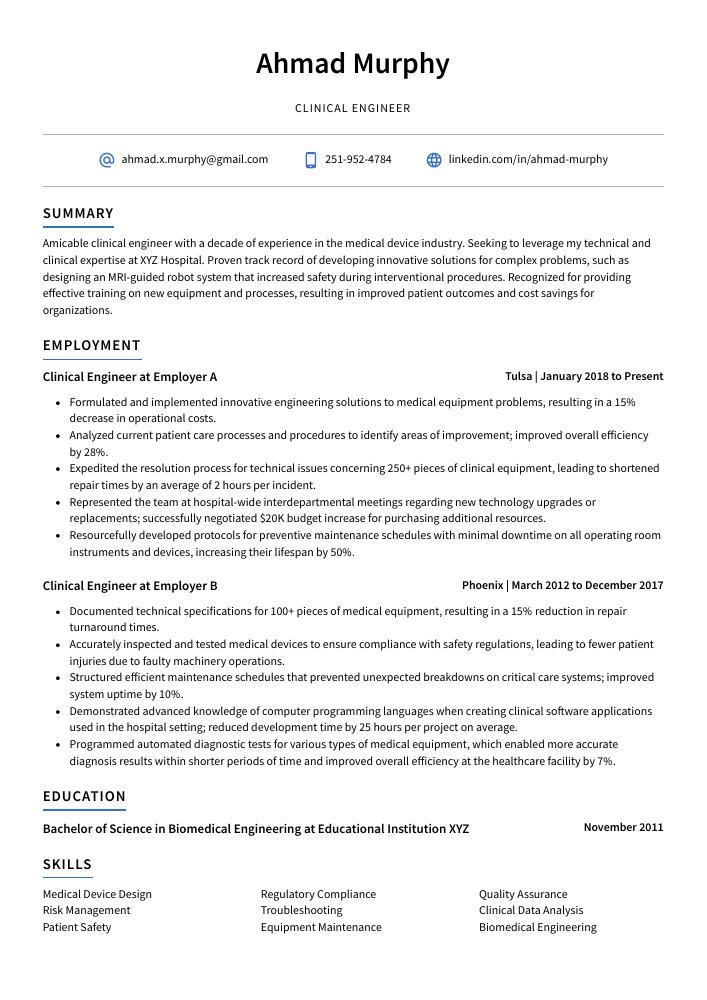Clinical Engineer Resume Guide
Clinical engineers are responsible for the design, development and maintenance of medical equipment used in clinical settings. They analyze existing systems to identify areas that need improvement and develop new products or processes to increase efficiency. Additionally, they provide technical support to healthcare professionals so they can use these devices safely and effectively.
Your technical knowledge and experience make you a great fit for any clinical engineering position. To get the attention of hiring managers, create a resume that highlights your unique qualifications and sets you apart from other applicants.
This guide will walk you through the entire process of creating a top-notch resume. We first show you a complete example and then break down what each resume section should look like.
Table of Contents
The guide is divided into sections for your convenience. You can read it from beginning to end or use the table of contents below to jump to a specific part.
Clinical Engineer Resume Sample
Ahmad Murphy
Clinical Engineer
[email protected]
251-952-4784
linkedin.com/in/ahmad-murphy
Summary
Amicable clinical engineer with a decade of experience in the medical device industry. Seeking to leverage my technical and clinical expertise at XYZ Hospital. Proven track record of developing innovative solutions for complex problems, such as designing an MRI-guided robot system that increased safety during interventional procedures. Recognized for providing effective training on new equipment and processes, resulting in improved patient outcomes and cost savings for organizations.
Experience
Clinical Engineer, Employer A
Tulsa, Jan 2018 – Present
- Formulated and implemented innovative engineering solutions to medical equipment problems, resulting in a 15% decrease in operational costs.
- Analyzed current patient care processes and procedures to identify areas of improvement; improved overall efficiency by 28%.
- Expedited the resolution process for technical issues concerning 250+ pieces of clinical equipment, leading to shortened repair times by an average of 2 hours per incident.
- Represented the team at hospital-wide interdepartmental meetings regarding new technology upgrades or replacements; successfully negotiated $20K budget increase for purchasing additional resources.
- Resourcefully developed protocols for preventive maintenance schedules with minimal downtime on all operating room instruments and devices, increasing their lifespan by 50%.
Clinical Engineer, Employer B
Phoenix, Mar 2012 – Dec 2017
- Documented technical specifications for 100+ pieces of medical equipment, resulting in a 15% reduction in repair turnaround times.
- Accurately inspected and tested medical devices to ensure compliance with safety regulations, leading to fewer patient injuries due to faulty machinery operations.
- Structured efficient maintenance schedules that prevented unexpected breakdowns on critical care systems; improved system uptime by 10%.
- Demonstrated advanced knowledge of computer programming languages when creating clinical software applications used in the hospital setting; reduced development time by 25 hours per project on average.
- Programmed automated diagnostic tests for various types of medical equipment, which enabled more accurate diagnosis results within shorter periods of time and improved overall efficiency at the healthcare facility by 7%.
Skills
- Medical Device Design
- Regulatory Compliance
- Quality Assurance
- Risk Management
- Troubleshooting
- Clinical Data Analysis
- Patient Safety
- Equipment Maintenance
- Biomedical Engineering
Education
Bachelor of Science in Biomedical Engineering
Educational Institution XYZ
Nov 2011
Certifications
Certified Clinical Engineer (CCE)
American College of Clinical Engineering
May 2017
1. Summary / Objective
Your resume summary should be a brief, yet powerful statement that captures the essence of who you are as a clinical engineer. In this section, you can highlight your experience in designing and implementing medical device systems for hospitals and clinics, any certifications or qualifications you possess related to healthcare technology management (HTM), and how your technical expertise has helped improve patient outcomes.
Below are some resume summary examples:
Enthusiastic clinical engineer with 5+ years of experience in overseeing the installation, maintenance, and repair of medical equipment. At XYZ Hospital, was responsible for evaluating new products to ensure compliance with safety regulations. Developed a process that reduced downtime by 40% and implemented cost-saving measures resulting in an estimated savings of $40K annually. Experienced at working collaboratively across all departments to ensure smooth operations.
Driven clinical engineer with 5+ years of experience in developing, maintaining and managing medical equipment. Experienced in all areas of clinical engineering, from design to installation and troubleshooting. At XYZ Hospital, led a successful project for the development of an automated system that improved patient care by 25%. Proven track record in training personnel on new technologies and conducting safety assessments to ensure compliance with regulations.
Determined clinical engineer with 5+ years of experience in designing and troubleshooting medical equipment. At XYZ, led the design and development of new life-saving technologies that reduced hospital costs by 15%. Certified in multiple healthcare regulations (ISO 13485, IEC 60601) which enables providing high-standard products for patient safety. Adept at working with various software systems to ensure optimal performance of all related hardware components.
Skilled clinical engineer with 5+ years of experience in planning, designing and implementing clinical engineering projects to optimize healthcare services. Seeking a challenging role at ABC Healthcare where I can use my expertise in medical device installation and maintenance processes to ensure the highest level of patient safety. At XYZ Hospitals, identified key areas for process improvement that resulted in an 11% increase in efficiency.
Professional clinical engineer with 8+ years of experience in clinical engineering, biomedical equipment maintenance and repair. Proven record of success implementing preventive maintenance plans for medical devices to ensure patient safety and satisfaction. Seeking to join ABC Medical Center as a Clinical Engineer using technical knowledge, problem-solving skills, and team collaboration abilities to support the healthcare team’s mission.
Committed clinical engineer with 5+ years of experience maintaining, troubleshooting, and repairing medical equipment. Up-to-date on modern technologies to ensure the safe operation of systems in healthcare facilities. At XYZ Hospital achieved a 98% success rate for preventive maintenance projects while reducing costs by 20%. Seeking to join ABC Tech and apply expertise towards innovative solutions that benefit patient care.
Detail-oriented clinical engineer with 5+ years of experience in the medical device and healthcare technology industry. Seeking to join ABC Corp as a Clinical Engineer to leverage expertise in troubleshooting, testing, and repairing complex medical equipment. At XYZ Inc., improved installation process time by 20% while ensuring safety protocols were met.
Accomplished clinical engineer with 7+ years of experience in the medical and healthcare industry. Skilled in troubleshooting, repairing and installing medical equipment while maintaining a safe work environment. Looking to utilize my skillset at ABC Healthcare to provide reliable maintenance services for their extensive range of clinical equipment.
2. Experience / Employment
For the experience section, list your roles in reverse chronological order, with the most recent one at the top. When you write about what you did for each role, use bullet points to make it easier to read and digest.
Try to provide as much detail as possible when writing out these bullet points; this will give a better understanding of what exactly you were responsible for and how successful your efforts were. For example, instead of saying “Installed medical equipment,” say something like “Installed complex medical imaging systems in accordance with industry standards within budgeted time frames.”
To write effective bullet points, begin with a strong verb or adverb. Industry specific verbs to use are:
- Installed
- Monitored
- Evaluated
- Calibrated
- Programmed
- Troubleshot
- Documented
- Serviced
- Inspected
- Tested
- Repaired
- Upgraded
- Configured
- Analyzed
- Optimized
Other general verbs you can use are:
- Achieved
- Advised
- Assessed
- Compiled
- Coordinated
- Demonstrated
- Developed
- Expedited
- Facilitated
- Formulated
- Improved
- Introduced
- Mentored
- Participated
- Prepared
- Presented
- Reduced
- Reorganized
- Represented
- Revised
- Spearheaded
- Streamlined
- Structured
- Utilized
Below are some example bullet points:
- Repaired and maintained clinical equipment such as imaging machines, ventilators and surgical instruments; improved overall machine uptime by 25%.
- Evaluated new medical devices for safety protocols, suitability of purpose and cost-effectiveness; reduced total expenditure on medical device purchases by $20K in the last year.
- Prepared detailed reports to document all repairs made to biomedical equipment; saved 10 hours of administrative time every month due to automated report generation processes.
- Reliably implemented preventative maintenance plans with minimum disruption or downtime in hospital wards/clinics patient care services; increased operational efficiency across 5 departments by 20%.
- Improved quality control measures when calibrating medical devices before use during procedures, achieving an average accuracy rate of 99% over 6 months’ period.
- Assessed clinical engineering needs of 10+ hospitals, developing efficient maintenance strategies that saved up to 35% in operational costs.
- Revised and updated existing medical equipment protocols according to the latest safety regulations; modified over 50 pieces of outdated machinery, resulting in a 15% reduction in regulatory audit violations.
- Developed detailed documentation on clinical engineering operations and procedures for all staff members; reduced training times by 20 hours per month on average.
- Meticulously maintained records of all tests, calibrations and inspections relating to medical devices within healthcare facilities; ensured full compliance with governmental standards at all times.
- Configured complex network systems consisting of hardware and software components for automated data collection from hospital databases; increased accuracy rate by 17%.
- Proficiently serviced a wide range of medical equipment, including diagnostic imaging systems, patient monitoring devices and laboratory analyzers; reduced service time by 10% while increasing accuracy to 98%.
- Achieved cost savings of $7000 per quarter through the implementation of innovative maintenance techniques on all clinical machinery.
- Presented detailed reports regarding performance levels and technical issues with various pieces of medical technology at monthly team meetings.
- Optimized daily workflow processes for 25+ staff members in the department to ensure that servicing tasks were completed within required deadlines without compromising quality standards or safety regulations.
- Developed training programs for over 50 new hires related to safe operation and troubleshooting methods for different types of clinical engineering equipment used in healthcare facilities with an overall satisfaction rating exceeding 90%.
- Calibrated and maintained medical equipment and devices per manufacturer instructions; optimized performance of over 200 pieces of equipment, resulting in a 15% reduction in repairs needed.
- Utilized advanced diagnostic tools to troubleshoot problems and performed preventive maintenance on all types of clinical technologies such as imaging systems, patient monitors, infusion pumps and ventilators according to hospital protocols.
- Advised nursing staff regarding the safe operation & use of medical technology while ensuring regulatory compliance with federal standards like HIPAA; reduced healthcare liability by 12%.
- Actively participated in the installation process for new biomedical equipment across multiple departments within the facility; led training sessions for 50+ personnel on proper usage techniques that increased safety protocols significantly (+15%).
- Mentored 8 junior technicians during their apprenticeship program, providing guidance on best practices for servicing/repairing clinical instruments efficiently within budgeted time frames (improved workflow by 25%).
- Thoroughly tested, troubleshot and maintained a wide range of medical equipment, ranging from x-ray machines to ventilators; reduced patient diagnosis time by 15%.
- Developed preventative maintenance plans for 20+ pieces of clinical engineering equipment per month that enabled teams to reliably identify potential issues before they caused any problems.
- Troubleshot complex technical issues with various biomedical devices quickly and efficiently while adhering strictly to safety standards in order to minimize downtime costs by $3000/month on average.
- Reduced the risk of noncompliance among healthcare professionals when using advanced diagnostic systems through comprehensive training sessions delivered both online and in person over 4 months across 3 departments at the hospital network.
- Facilitated upgrades for 50+ specialized instruments used in surgical environments resulting in improved accuracy rates up 25% compared pre-upgrade performance metrics.
- Spearheaded installation and maintenance of medical equipment onsite across 15+ hospitals, ensuring optimal performance while reducing safety risks by 50%.
- Installed new diagnostic devices in 7 operating rooms to improve patient care quality; saved the hospital $200K annually in operational costs.
- Introduced a comprehensive preventive maintenance program that reduced service call frequency by 30% and improved response time for critical repairs by 25%.
- Reorganized inventory management processes resulting in efficient use of medical tools & supplies, leading to an average cost reduction of 20% per quarter.
- Efficiently troubleshooted complex issues with specialized healthcare technology within 24 hours, minimizing disruptions from technical malfunctions or breakdowns.
- Participated in the installation, calibration and maintenance of complex med tech equipment for 5+ hospitals across the country; achieved a 90% success rate in preventive repairs.
- Monitored 25+ medical systems regularly to ensure optimal performance levels, troubleshooting any issues quickly and restoring functionality within 3 hours on average.
- Upgraded various legacy healthcare systems with latest software releases while ensuring HIPAA compliance; improved overall system speed by 22%.
- Substantially reduced downtime costs through preventative diagnostics and repair techniques; saved $30K in operational expenses over 2 years period.
- Coordinated activities between clinical engineers, IT staff & healthcare professionals to facilitate smooth functioning of medical devices at all times.
- Compiled reports for over 200 medical device installations and repairs each month, resulting in a 15% increase in overall operational efficiency.
- Successfully developed and implemented new software protocols to support the maintenance of over 100 pieces of clinical equipment, cutting repair time by 20%.
- Streamlined procedures for clinical device calibration and troubleshooting, reducing downtime from 8 hours to 4 on average per machine; saved $20k in annual repair costs as a result.
- Inspected malfunctioning equipment used in patient care settings such as X-ray machines and ultrasound systems; identified problems quickly and accurately with minimal disruption to operations 90% of the time.
3. Skills
Even though two organizations are hiring for the same role, the skillset they want an ideal candidate to possess could differ significantly. For instance, one may be on the lookout for an individual with knowledge of medical imaging systems, while the other may prioritize experience in biomedical engineering.
Therefore, you must tailor your skills section to each job that you are applying for; this will help ensure that applicant tracking systems pick up on the right keywords and consider your resume a high-quality match for the role.
You can further elaborate on these skills by discussing them more thoroughly in other sections such as work experience or summary statement.
Below is a list of common skills & terms:
- Biomedical Engineering
- Clinical Data Analysis
- Diagnostic Imaging Systems
- Equipment Maintenance
- Medical Device Design
- Patient Safety
- Quality Assurance
- Regulatory Compliance
- Risk Management
- Troubleshooting
4. Education
Including an education section on your resume will depend on how far along you are in your career. If you just graduated and have no work experience, it is important to include this information below your resume objective. However, if you have significant work experience that speaks for itself, then the education section may not be necessary.
If an education section is included, make sure to mention courses related to clinical engineering such as biomedical equipment technology or healthcare systems management. You can also list any certifications or degrees obtained relevant to the role of a clinical engineer.
Bachelor of Science in Biomedical Engineering
Educational Institution XYZ
Nov 2011
5. Certifications
Certifications are a great way to demonstrate your expertise in a particular field. They show potential employers that you have the necessary knowledge and skills required for the job, as well as having been tested by an independent organization.
If you are certified in any specific skill related to the job role, make sure to include this information on your resume so that hiring managers can see how qualified you are for the position.
Certified Clinical Engineer (CCE)
American College of Clinical Engineering
May 2017
6. Contact Info
Your name should be the first thing a reader sees when viewing your resume, so ensure its positioning is prominent. Your phone number should be written in the most commonly used format in your country/city/state, and your email address should be professional.
You can also choose to include a link to your LinkedIn profile, personal website, or other online platforms relevant to your industry.
Finally, name your resume file appropriately to help hiring managers; for Ahmad Murphy, this would be Ahmad-Murphy-resume.pdf or Ahmad-Murphy-resume.docx.
7. Cover Letter
Including a cover letter with your job application is essential if you want to make a great first impression on the hiring manager. It provides them with additional information about who you are and what makes you an ideal candidate for the role.
Cover letters typically have 2-4 paragraphs and should include details that aren’t already mentioned in your resume. They also provide recruiters with insights into why they should choose you over other applicants, giving them a better understanding of how well suited you are for the position.
Below is an example cover letter:
Dear Jamie,
I am writing in response to your recent posting for a Clinical Engineer. With extensive experience in medical device management, troubleshooting, and maintenance, as well as a Bachelor’s degree in Biomedical Engineering and hospital-based clinical engineering training, I feel confident I would be an excellent fit for this position.
In my current role at [hospital name], I oversee the operation of all medical equipment and devices throughout the facility. This includes everything from ventilators and defibrillators to x-ray machines and MRI scanners. My duties include preventative maintenance schedules, inventory management, budgeting for new purchases, conducting repairs as needed, and providing staff training on proper equipment use.
Through my years of experience working with medical devices of all kinds, I have developed strong problem solving skills that enable me to quickly identify issues and find efficient solutions. My background in biomedical engineering gives me a thorough understanding of how these devices work which is essential in ensuring they are always operating safely and correctly. Additionally, my outstanding communication skills allow me to effectively train staff on proper procedures while also maintaining positive relationships with vendors when coordinating repairs or replacements.
I believe strongly that every patient deserves access to high quality care made possible by properly functioning medical equipment. It would be my privilege to bring my expertise in clinical engineering to your team at [hospital name] where I can help ensure optimal patient outcomes through effective device management. Thank you for your time; I look forward to speaking with you soon about this opportunity.
Sincerely,
Ahmad
Clinical Engineer Resume Templates
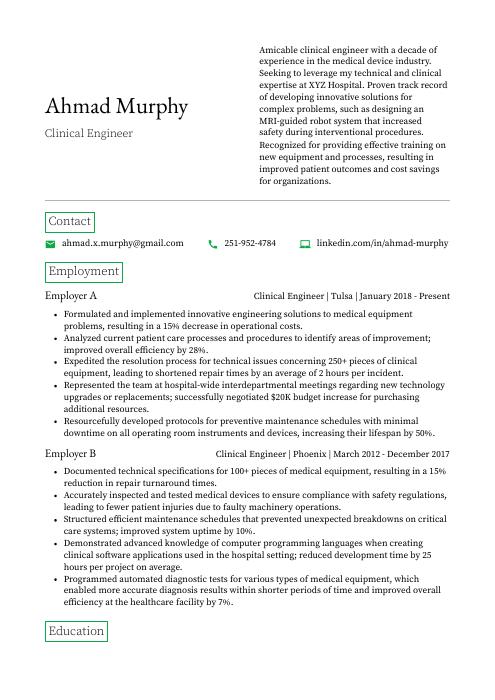 Quokka
Quokka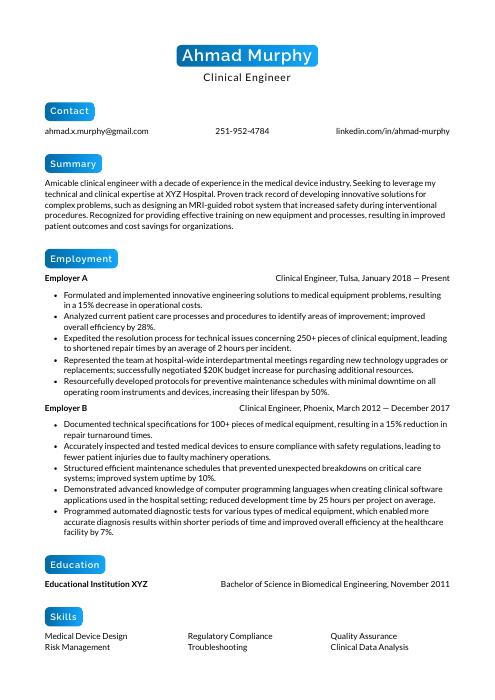 Kinkajou
Kinkajou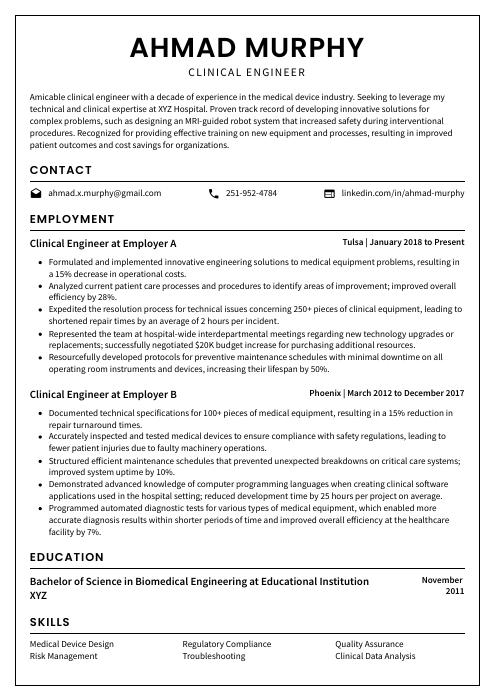 Cormorant
Cormorant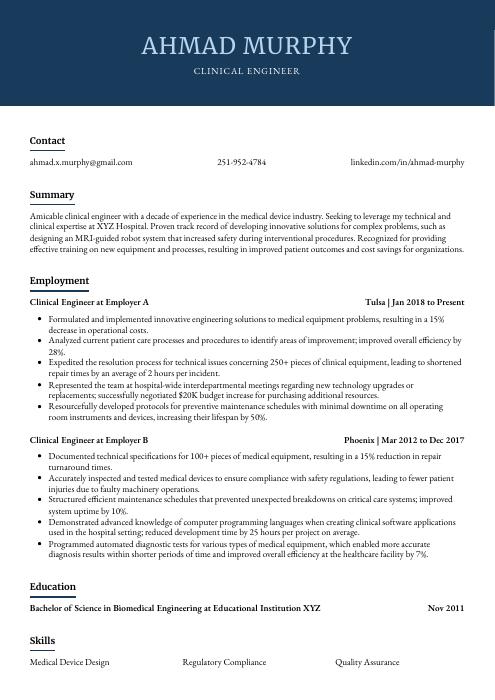 Bonobo
Bonobo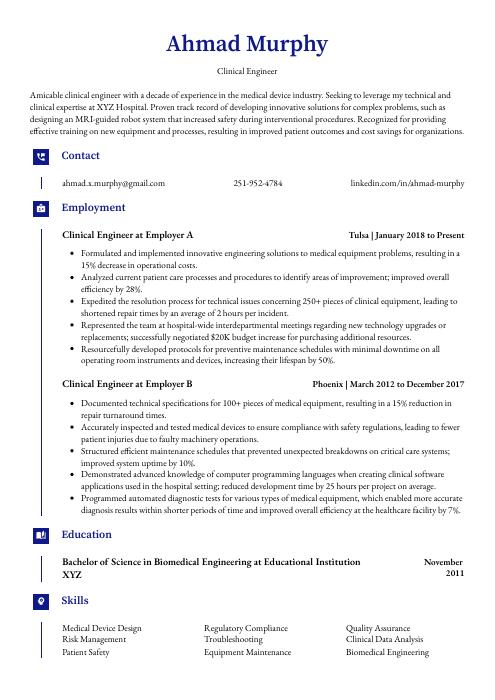 Gharial
Gharial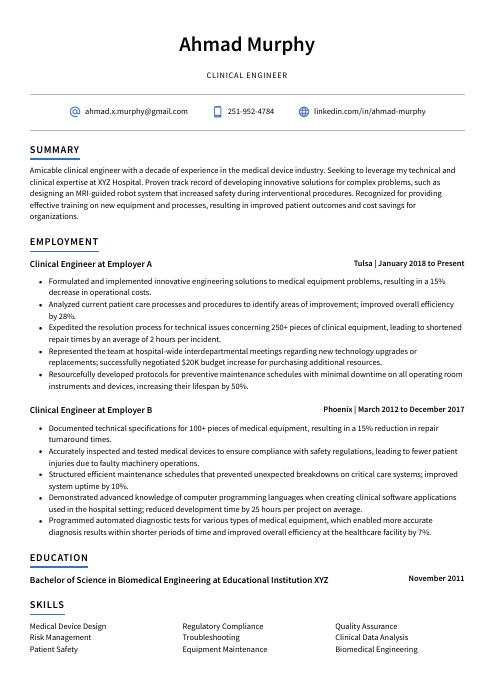 Axolotl
Axolotl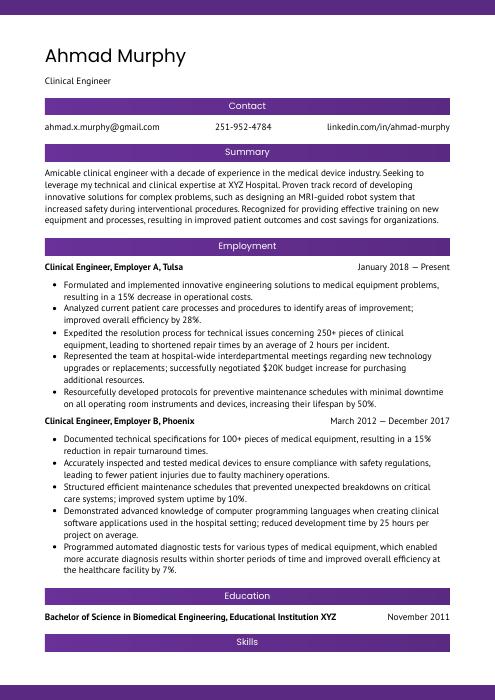 Jerboa
Jerboa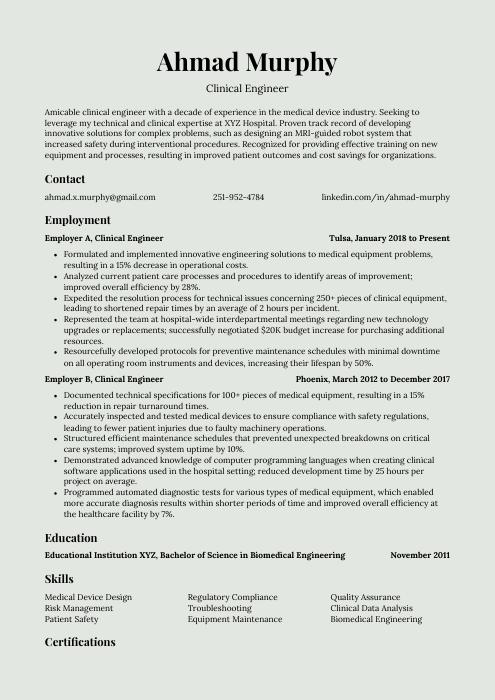 Saola
Saola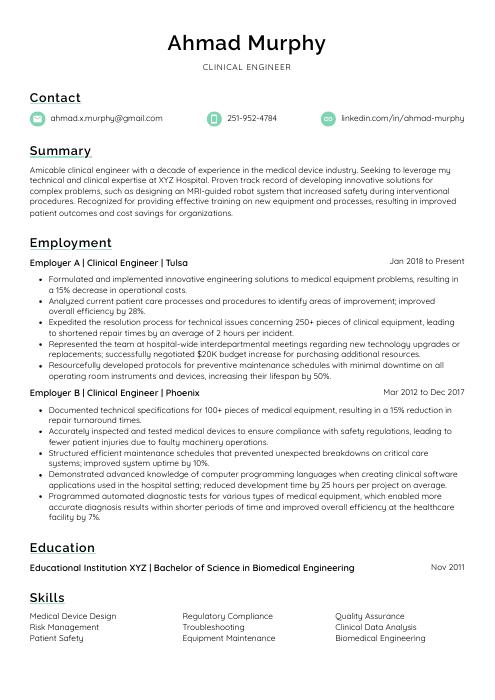 Lorikeet
Lorikeet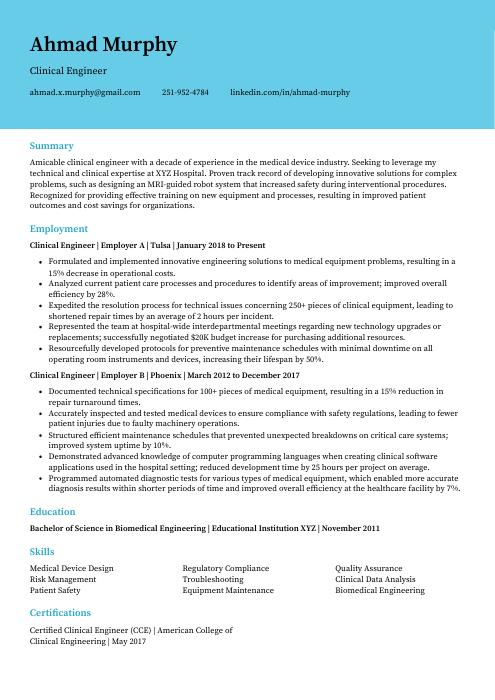 Dugong
Dugong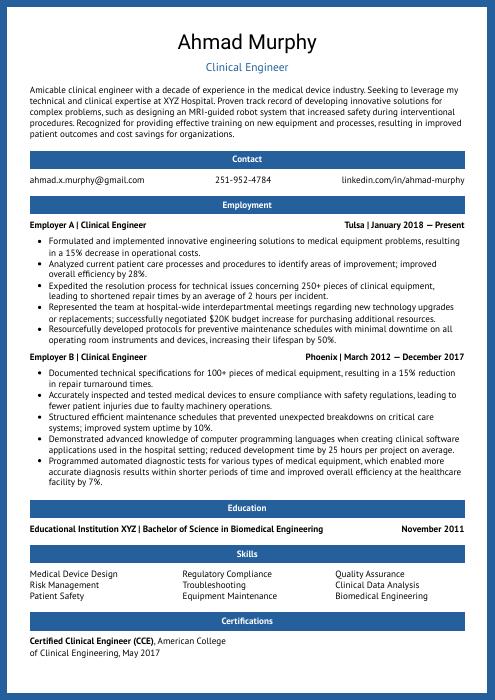 Ocelot
Ocelot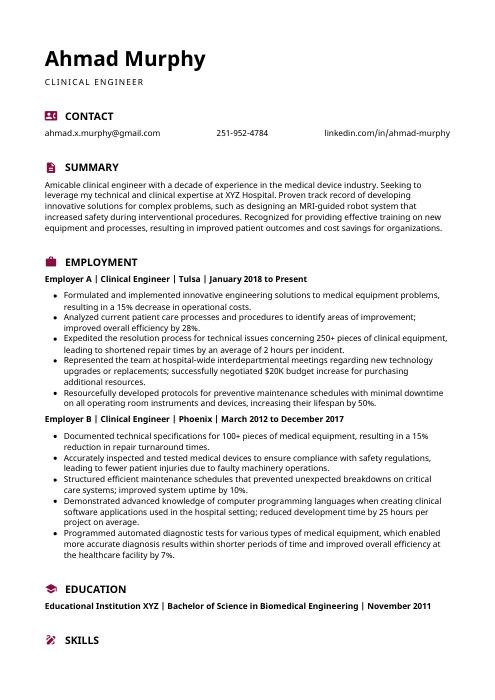 Hoopoe
Hoopoe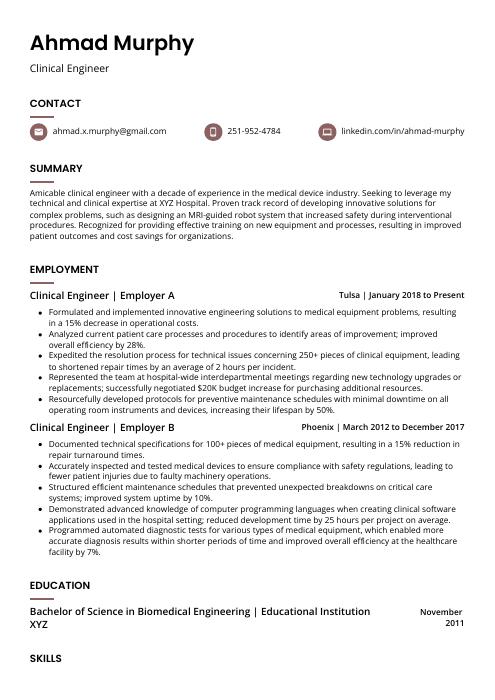 Fossa
Fossa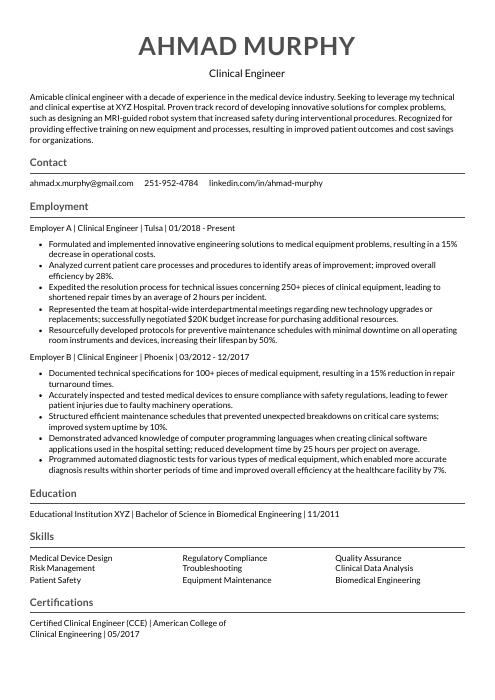 Indri
Indri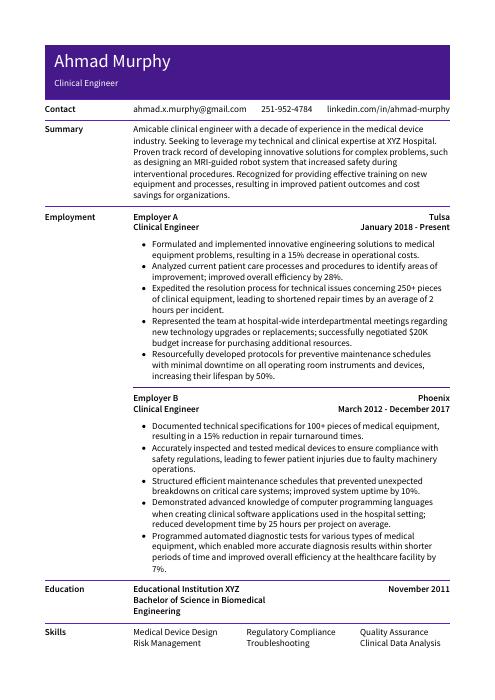 Pika
Pika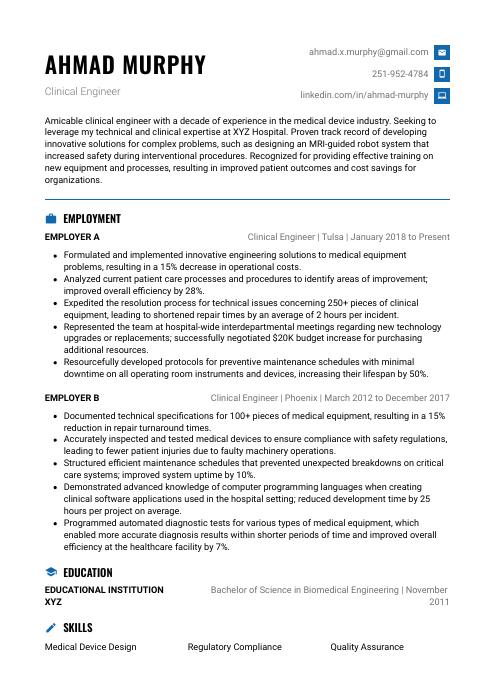 Echidna
Echidna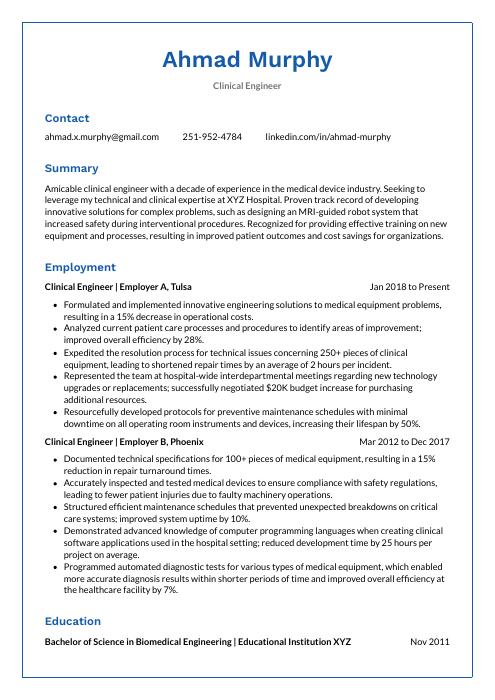 Markhor
Markhor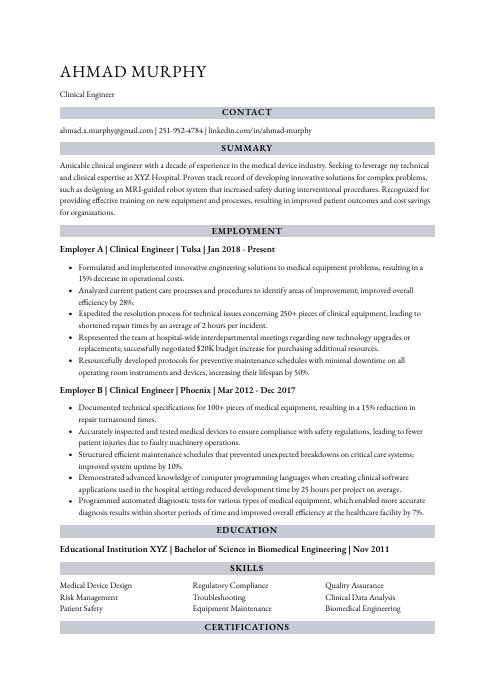 Numbat
Numbat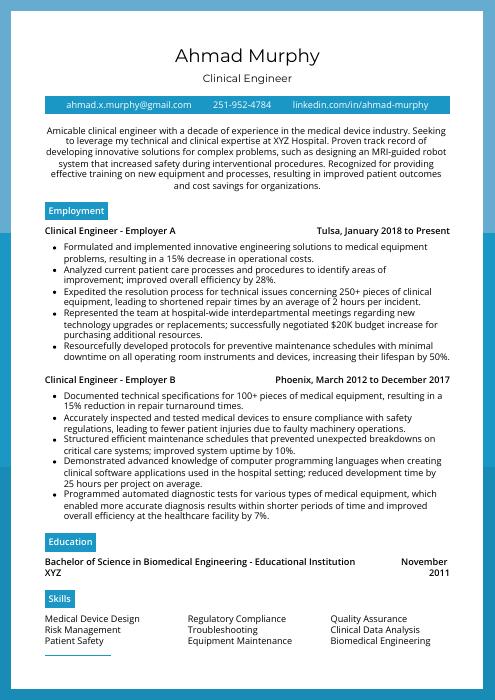 Rhea
Rhea Rezjumei
Rezjumei
